3 Careers and Internships: Connecting Career to College
Lakeisha Mathews and Linda Bruce
Career Exploration
There are any number of reasons students decide to come to college. Can you identify your tops reasons for choosing to pursue a degree? Some students choose to attend college right after high school to pursue a specific career. Others, choose college because they do not have a defined career goal and want to explore their options. There are also adult learners who return to college or start college after starting a family to change careers or advance in their career field. Chances are regardless of why you decided to attend college or what college you enroll in you expect your academic experience to help you advance professionally.
Employment Rates and Salaries
Consider, too, the following statistics on employment rates and salaries for college graduates. College does make a big difference!
- The average college graduate earns about 75 percent more than a non-college graduate over a typical, forty-year working lifetime. (U.S. Census Bureau)[2]
- In 2014, young adults ages 20 to 24 with a bachelor’s degree or higher had a higher employment rate (88.1 percent) than young adults with just some college (75.0 percent). (NCES)
- The employment rate for young adults with just some college (63.7 percent) was higher than the rate for those who had completed high school. (NCES)
- The employment rate for those who completed high school (46.6 percent) was higher than the employment rate for young adults who had not finished high school. (NCES)
- Employment rates were generally higher for males than females at each level of educational attainment in 2014. (NCES)[3]
- Over the course of a forty-year working life, the typical college graduate earns an estimated $550,000 more than the typical high school graduate. (PEW)
- The median gap in annual earnings between a high school and college graduate as reported by the U.S. Census Bureau in 2010 is $19,550. (PEW)[4]
Perhaps most important, an overwhelming majority of college graduates—86 percent—say that college has been a good investment for them personally. (PEW)
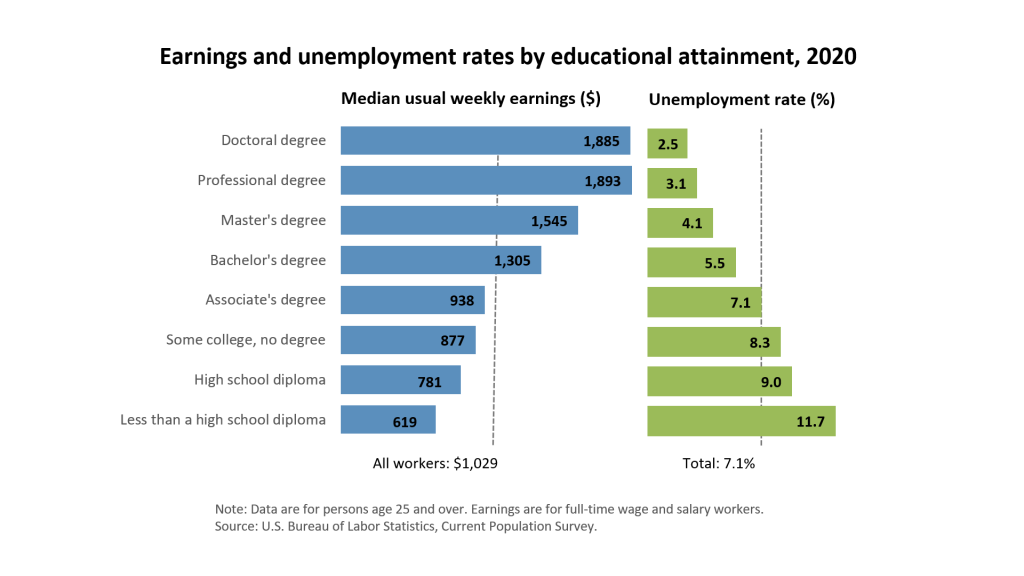
Despite the desire to launch, advance or change your career path after graduation, some students’ complete college and struggle to find meaningful work. This is because career planning is an action-oriented process that must be engaged in during your academic experiences starting in your freshman year. It is often too late to start career planning in the last semester of your senior year. Job searching takes 3–6 months and longer in some industries. And, that is not including taking the time to reflect on the type of work you want to do, the positions available, and ensuring that you are career ready.
So what is career planning?
According to Schermerborn, Hunt, and Osborn (2002), “Career planning takes the form of structured opportunities” to work on career issues. The authors go on to explain that the steps involved in career planning includes mapping career goals, assessing personal developments needs, and planning short and long-term career moves (Schermerborn, Hunt, and Osborn, 2002, pg. 59). For the sake of this text, career planning is defined as the intentional and ongoing practice of reflecting, planning and taking-action concerning one’s future occupational goals.
- Intentional: Career Planning is an intentional process…
- Ongoing: Career Planning is an ongoing process…
- Reflecting: Career planning requires reflecting…
- Planning: Career planning requires planning
- Action: career planning requires action
Differences in Earnings between States
You may wish to use this Earnings and Educational Attainment (2011) interactive table to see how earnings for college graduates vs. high school–only graduates in your state compare with those in other states.
All in all, college imparts a wide and deep range of benefits.
- Have a higher salary
- Have and keep a job
- Get a pension plan
- Be satisfied with your job
- Feel your job is important
- Have health insurance
Career Readiness: NACE
Each year thousands of college graduates transition into the workplace. And, each year, employers share their thoughts on the abilities of recent graduates. According to the the Association of American Colleges and Universities, 82% of executives and hiring managers see a college degree as very important or essential (AAC&U, 2018). However, the degree along is not enough. Employers also expect recent graduates to be “Career Ready.” When surveyed by the National Association of Colleges and Employers, companies identified the following competencies as essential qualities of a career ready professional:
- Critical Thinking/Problem Solving
- Oral/Written Communications
- Teamwork/Collaboration
- Digital Technology
- Leadership
- Professionalism/Work Ethic
- Career Management
- Global/Intercultural Fluency
Learn more about the NACE Career Readiness competencies here.
To assess your career readiness, take the Employability Skills Self-Assessment tool developed by the College & Career Readiness & Success Center here.
Steps to Career Planning: The UBalt Career Cycle
What is career planning?
See if you can remember a time in your childhood when you noticed somebody doing professional work. Maybe a nurse or doctor, dressed in a lab coat, was listening to your heartbeat. Maybe a worker at a construction site, decked in a hard hat, was operating noisy machinery. Maybe a cashier at the checkout line in a grocery store was busily scanning bar codes. Each day in your young life you could have seen a hundred people doing various jobs. Surely some of the experiences drew your interest and appealed to your imagination.
If you can recall any such times, those are moments from the beginning stage of your career development. What exactly is career development? It’s a lifelong process in which we become aware of, interested in, knowledgeable about, and skilled in a career. It’s a key part of human development as our identity forms and our life unfolds.
There are five main stages of career development. Each stage correlates with attitudes, behaviors, and relationships we all tend to have at that point and age. As we progress through each stage and reach the milestones identified, we prepare to move on to the next one.
Which stage of career development do you feel you are in currently? Think about each stage. What challenges are you facing now? Where are you headed?
| # | STAGE | DESCRIPTION |
| 1 | GROWING | This is a time in early years (4–13 years old) when you begin to have a sense about the future. You begin to realize that your participation in the world is related to being able to do certain tasks and accomplish certain goals. |
| 2 | EXPLORING | This period begins when you are a teenager, and it extends into your mid-twenties. In this stage you find that you have specific interests and aptitudes. You are aware of your inclinations to perform and learn about some subjects more than others. You may try out jobs in your community or at your school. You may begin to explore a specific career. At this stage, you have some detailed “data points” about careers, which will guide you in certain directions. |
| 3 | ESTABLISHING | This period covers your mid-twenties through mid-forties. By now you are selecting or entering a field you consider suitable, and you are exploring job opportunities that will be stable. You are also looking for upward growth, so you may be thinking about an advanced degree. |
| 4 | MAINTAINING | This stage is typical for people in their mid-forties to mid-sixties. You may be in an upward pattern of learning new stills and staying engaged. But you might also be merely “coasting and cruising” or even feeling stagnant. You may be taking stock of what you’ve accomplished and where you still want to go. |
| 5 | REINVENTING | In your mid-sixties, you are likely transitioning into retirement. But retirement in our technologically advanced world can be just the beginning of a new career or pursuit—a time when you can reinvent yourself. There are many new interests to pursue, including teaching others what you’ve learned, volunteering, starting online businesses, consulting, etc. |
Keep in mind that your career-development path is personal to you, and you may not fit neatly into the categories described above. Perhaps your socioeconomic background changes how you fit into the schema. Perhaps your physical and mental abilities affect you define the idea of a “career.” And for everyone, too, there are factors of chance that can’t be predicted or anticipated. You are unique, and your career path can only be developed by you.
What steps are involved in the career planning process? According to The University of Baltimore, there are four phases to the career planning process. Each phase requires intentional career planning and reflection and concludes with a career-related action step. The model is known as the UBalt Career Cycle. The four phases are: (1) Discover Your Direction, (2) Explore the World of Work, Communicate Your Brand, and (4) Create Your Opportunities.
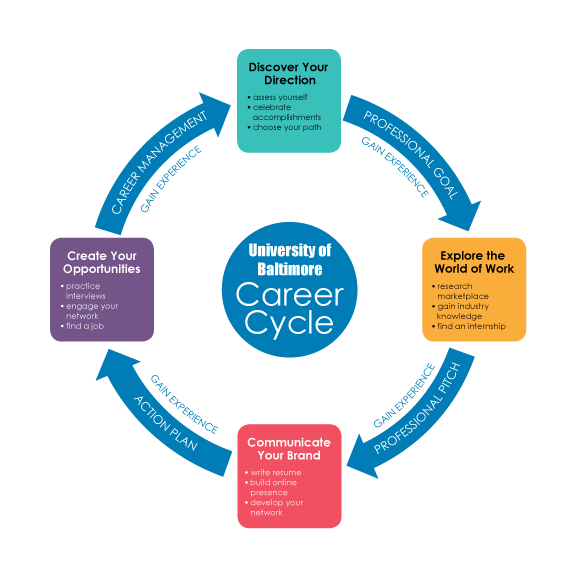
The remainder of this book will focus on the four phases of the UBalt Career Cycle. Of note, the UBalt Career Cycle is recognized nationally and was lauded for its impact on student success by University Business Magazine in 2015.
Discover Your Direction
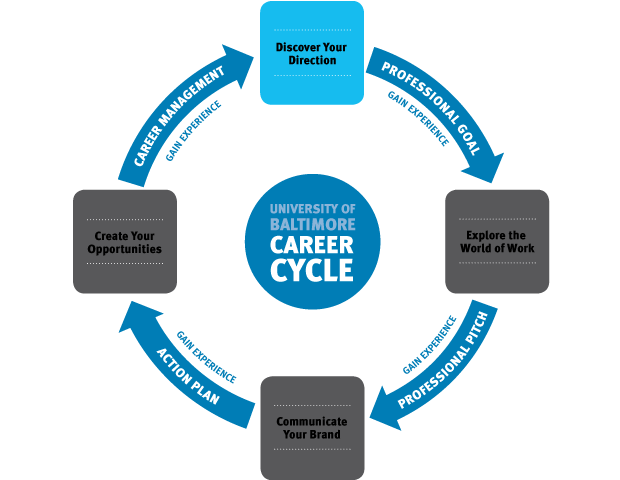
The first phase of the UBalt Career Cycle is Discover Your Direction. In this phase students take time to think about the occupations that interest them, select a major, and/or identify a specific professional pathway. In order to Discover Your Direction, focus will be on learning more about yourself—not merely making a career decision. The more you know about yourself—your knowledge, skills, abilities, accomplishments and the values that drive you—the easier it will be to choose a major and career path.
Job Satisfaction
There are many benefits to selecting a good fit major and career pathway. Researchers cite the following outcomes for students who take time to select a pathway congruent with their interests and personality:
Academic Performance Benefits
According to Jones (2012) if you chose your major based on your personality and interests you will perform better academically including earning higher grades and graduating on time.
Career Satisfaction
According to Gallup (2002), the publishers of the Clifton Strengths Assessment say professionals who know and use their strengths, “are six times as likely to be engaged in their jobs and to strongly agree that they have the chance to do what they do best.”
Action Steps
As mentioned previously, each phase of the UBalt Career Cycle has an accompanying action step. Activities suggested to help you Discover Your Direction are to assess yourself, celebrate your accomplishments, and choose your path. The Action Step is to identify and write your Professional Goal.
| Discover Your Direction-Career Activities |
| Assess Yourself
Learn more about your interests, personality and strengths by taking a career assessment. Contact your Career Center for free assessments. |
Celebrate Your Accomplishments
Reflect on things you have done well or been recognized for a write them down. |
Choose Your Path
After assessing yourself and identifying your accomplishments, select your career path. |
|
Professional Goal Once you complete the career activities listed above you are ready to write a professional goal which states your intended career path. |
For assistance with this Action Step see the Professional Goal Worksheet. You can use the following resources to assess your interests and review your accomplishments:
- 16 Personalities
- Keirsey Temperament Assessment
- Writing Accomplishments Statements
- What Can I Do With Major In…
What Do You Want To Do
Sometime when students approach the career planning process they immediately begin thinking about salary, “safe careers,” or perceived prestigious careers. Few are challenged to think beyond “what they want be” to focus on “what they want to do.” For instance, wanting to become a doctor to save lives is different thank wanting to become a doctor because it is considered a prestigious. After drafting your Professional Goal, go back and consider if your statement incorporates your “What”—how will you impact the world with your career choice.
Choosing a Career
As your thoughts about career expand, keep in mind that over the course of your life, you will probably spend a lot of time at work—thousands of hours, in fact. According to the Bureau of Labor Statistics, the average workday is about 8.7 hours long, and this means that if you work 5 days a week, 50 weeks a year, for 35 years, you will spend a total of 76,125 hours of your life at work. These numbers should convince you that it’s pretty important to enjoy your career!
If you do pursue a career, you’ll find yourself making many decisions about it. Is this the right job for me? you may ask. Am I feeling fulfilled and challenged? Does this job enable me to have the lifestyle I desire? It’s important to consider these questions now, whether you’re just graduating from high school or college, or you’re returning to school after working for a while.
Choosing a career—any career—is a unique process for everyone, and for many people the task is daunting. There are so many different occupations to choose from. How do you navigate this complex world of work?
Video: https://youtu.be/vMiSf7LpFQ
Explore the World of Work
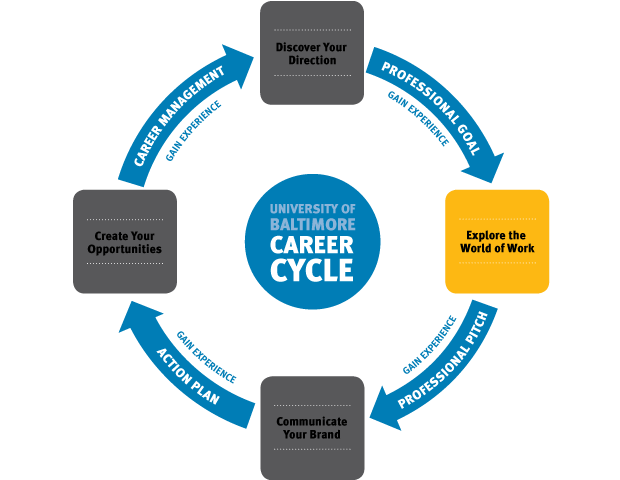
The second Phase of the UBalt Career Cycle is Explore the World of Work. In this phase students search for their “sweet spot.” The goal is to confirm that your professional goal is a good fit. In this phase, you’re encouraged to learn about trends in your field, problems you want to solve and challenges you will face. This phase of the Career Cycle is similar to purchasing a car. Most people research and test drive multiple vehicle before making a purchase. Some consumer needs to narrow down the brand they want to purchase. Others know what brand they are interested in but need to narrow down the model. Exploring the Work of Work is similar, students research a career and even obtain internships to gain experience, These career activities can help a student learn more a particular major, career, or industry.
Action Steps
As mentioned previously, each phase of the UBalt Career Cycle has an accompanying action step. Activities suggested to help you Explore the World of Work are to research the marketplace, gain industry knowledge, and find an internship. The Action Step is to craft and practice your Professional Pitch.
| Explore the World of Work – Career Activities | ||
| Research the Marketplace | Gain Industry Knowledge | Find an Internship |
| Research careers, industries and companies you are considering for your next step. | As you research the marketplace, it’s very important that you learn the ins and outs of the industry and occupations you decide to pursue. | Internships are invaluable ways to experience the world of work firsthand. |
| Explore the World of Work – Action Step |
| Professional Pitch
Once you complete the career activities listed above you are ready to write a professional pitch which communicated your professional brand and career goal. |
For assistance with this Action Step see the Professional Pitch Worksheet. You can use the following resources to research the marketplace and gain industry knowledge:
About Internships—How to Gain Experience
Gaining experience is also a critical part of career planning. Participating in activities such as internships can help students explore a career, make contacts, find a mentor, and increase relevant skills, knowledge and abilities. The National Association of Colleges and Employers (2011) defines internships as follows:
| An internship is a form of experiential learning that integrates knowledge and theory learned in the classroom with practical application and skills development in a professional setting. Internships give students the opportunity to gain valuable applied experience and make connections in professional fields they are considering for career paths; and give employers the opportunity to guide and evaluate talent. (National Association of Colleges and Employers, 2011) |
According to Indeed.com (2020) there are twelve benefits to obtaining an internship in college including:
- Testing industry knowledge
- Helping you figure out your interests
- Creating new interests
- Connecting you to industry professionals
- Allowing you to learn in a safe environment
- Giving you the opportunity to get paid to learn
- Providing possible credit for your college degree
- Allowing you to potentially gain more internship opportunities
- Creating a unique travel experience
- Inspiring you to learn more about an industry
- Teaching you about the importance of work-life balance
- Introducing you to office politics
Gaining Experience is not limited to internships. There are alternative ways students can gain experience and build their academic portfolios. The Association of American Colleges and Universities (2008) includes undergraduate research, study abroad, community service and special projects as additional educational activities that help students explore career interests and gain experience.
Professional Pathways
Students who are not ready to select a specific career can start by identifying a professional pathway that interests them. Professional pathways are also called industries or career clusters and reflect a group of professions that are similar. For example, Business is a professional pathway composed of similar careers such as Finance, Accounting, and Management.
The University of Baltimore encourages students to start with a Professional Pathway before selecting an occupation. Professional Pathways at The University of Baltimore allow students to explore various academic programs in one Pathways without taking extra classes.
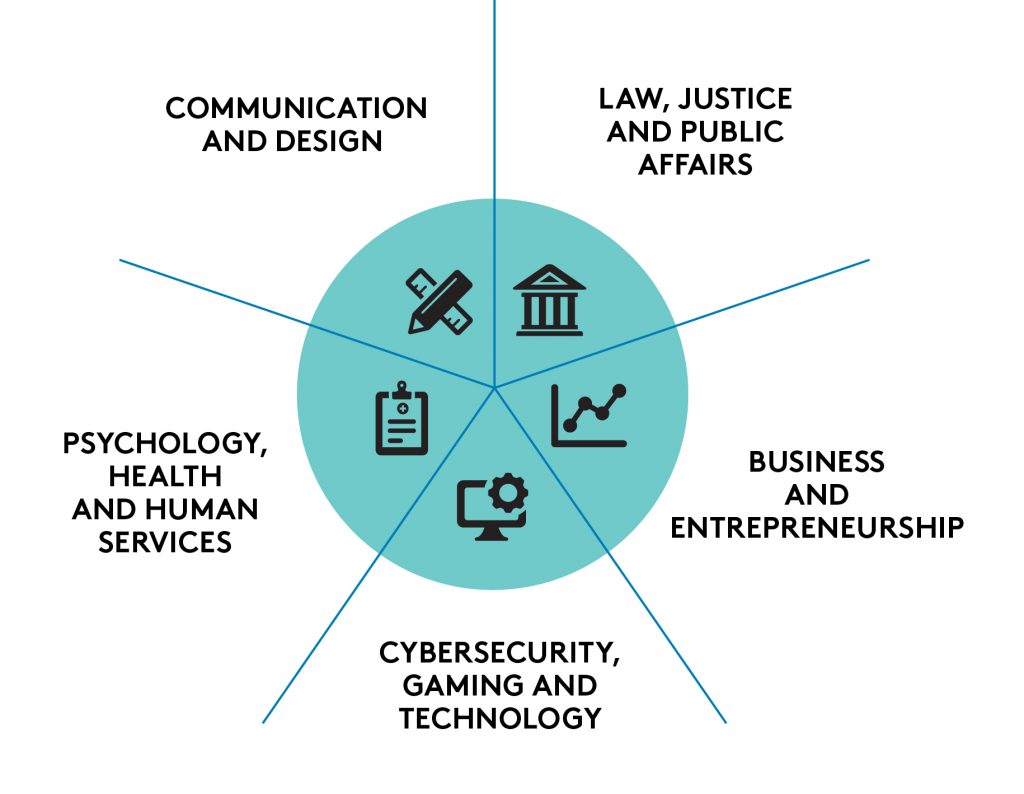
At The University of Baltimore and students academic experience is integrated with career development including personal career coaching, professional development, mentoring, gaining experience and more (see below):
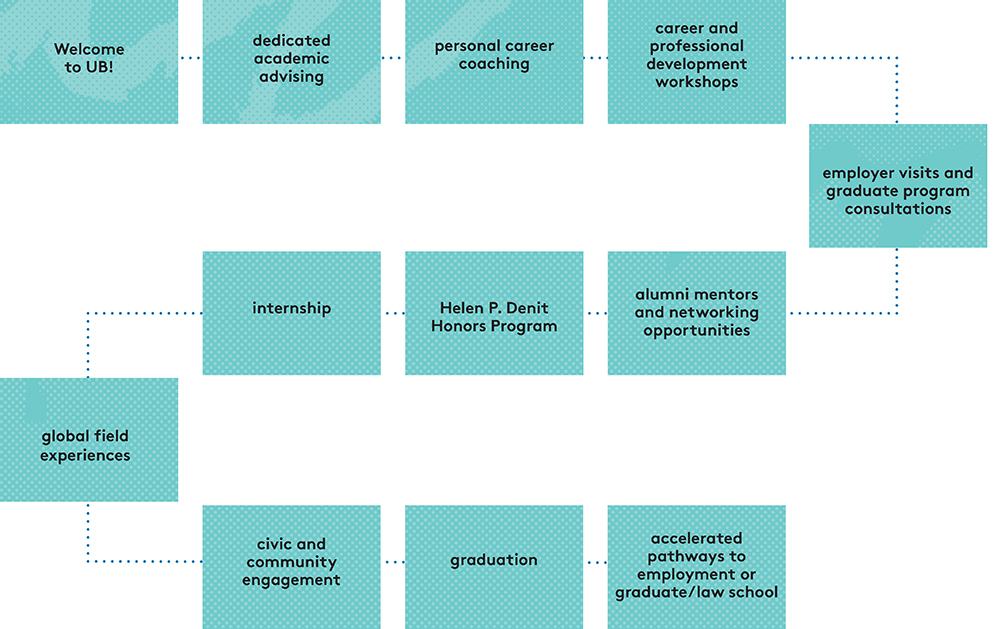
Just Get Involved
After you’ve networked with enough people and built up your reputation, your peers can connect you with job openings that may be a good fit for your skills. The video, below, from Monash University in Australia offers the following tips:
- Get involved in part-time work
- Get involved in extracurricular activities
- Get involved with employment and career development
“Just Get involved. There are so many opportunities and open doors for you.”
Communicate Your Brand
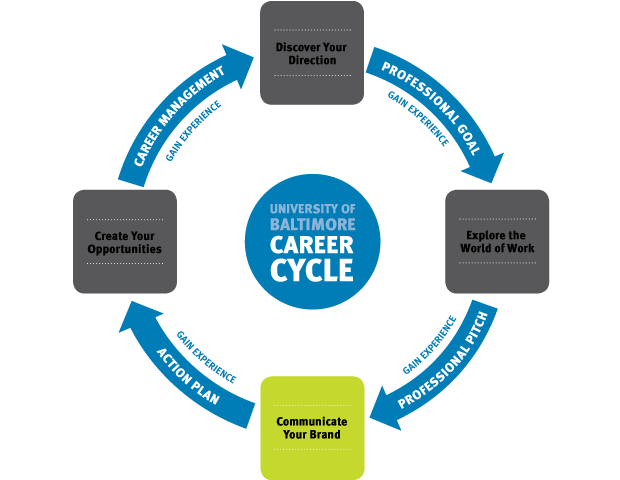
The third Phase of the UBalt Career Cycle is Communicate Your Brand. In this phase students begin to define or refine their professional brand by identifying the knowledge, skills, and abilities that differentiate them from everyone else. A Professional Brand reveals what makes you unique and well suited to pursue your career goal including obtaining an internship or a full time job.
Action Steps
As mentioned previously, each phase of the UBalt Career Cycle has an accompanying action step. Activities suggested to help you Communicate Your Brand include writing your resume, building an online presence and developing your network. The Action Step is to design your Action Plan.
| Communicate Your Brand –
Career Activities
|
||
| Write Your Resume | Build an Online Presence | Develop Your Network |
| Developing an error free resume that highlights your accomplishments and experience is an essential component of your brand | Your online presence also reflects your. Establishing a student profile on LinkedIn and maintaining a positive presence on other accounts is important.
|
The more professional contacts you have, the more opportunities you will have access to.
|
| Communicate Your Brand – Action Step |
| Career Action Plan
Once you complete the career activities listed above you are ready to communicate your brand. This will include developing professional documents, establishing a LinkedIn profile, and making business contacts. |
For assistance with this Action Step you can access the career Action Plan worksheet. You can also use the following resources to learn more about building a professional brand:
Strategies for Networking [College Success]
In the context of career development, networking is the process by which people build relationships with one another for the purpose of helping one another achieve professional goals.
When you “network,” you exchange information.
- You may share business cards, resumes, cover letters, job-seeking strategies, leads about open jobs, information about companies and organizations, and information about a specific field.
- You might also share information about meet-up groups, conferences, special events, technology tools, and social media.
- You might also solicit job “headhunters,” career counselors, career centers, career coaches, an alumni association, family members, friends, acquaintances, and vendors.
Networking can occur anywhere and at any time. In fact, your network expands with each new relationship you establish. And the networking strategies you can employ are nearly limitless. With imagination and ingenuity, your networking can be highly successful.
Networking Strategies at College
- Get to know your professors: Communicating with instructors is a valuable way to learn about a career and also get letters of reference if and when needed for a job. Professors can also give you leads on job openings, internships, and research possibilities. Most instructors will readily share information and insights with you. Get to know your instructors. They are a valuable part of your network.
- Check with your college’s alumni office: You may find that some alumni are affiliated with your field of interest and can give you the “inside scoop.”
- Check with classmates: Classmates may or may not share your major, but any of them may have leads that could help you. You could be just one conversation away from a good lead.
Networking Strategies at Work [College Success]
- Join professional organizations: You can meet many influential people at local and national meetings and events of professional and volunteer organizations. Learn about these organizations. See if they have membership discounts for students, or student chapters. Once you are a member, you may have access to membership lists, which can give you prospective access to many new people to network with.
- Volunteer: Volunteering is an excellent way to meet new people who can help you develop your career, even if the organization you are volunteering with is not in your field. Just by working alongside others and working toward common goals, you build relationships that may later serve you in unforeseen and helpful ways.
- Get an internship: Many organizations offer internship positions to college students. Some of these positions are paid, but often they are not. Paid or not, you gain experience relevant to your career, and you potentially make many new contacts.
- Get a part-time job: Working full-time may be your ultimate goal, but you may want to fill in some cracks or crevices by working in a part-time job. Invariably you will meet people who can feasibly help with your networking goals. And you can gain good experience along the way, which can also be noted on your resume.
- Join a job club: Your career interests may be shared by many others who have organized a club, which can be online or in person. If you don’t find an existing club, consider starting one.
- Attend networking events: There are innumerable professional networking events taking place around the world and also online. Find them listed in magazines, community calendars, newspapers, journals, and at the Web sites of companies, organizations, and associations.
- Conduct informational interviews: You may initiate contact with people in your chosen field who can tell you about their experiences of entering the field and thriving in it. Many Web sites have guidance on how to plan and conduct these interviews.
Networking Strategies at Home and Beyond
- Participate in online social media: An explosion of career opportunity awaits you with social media, including LinkedIn, Twitter, Facebook, Instagram, Pinterest, and many more. Keep your communication ultra-professional at these sites. Peruse magazine articles, and if you find one that’s relevant to your field and it contains names of professionals, you can reach out to them to learn more and get job leads.
- Ask family members and friends, coworkers, and acquaintances for referrals: Do they know others who might help you? You can start with the question “Who else should I be talking to?”
- Use business cards or networking cards: A printed business card can be an essential tool to help your contacts remember you. Creativity can help in this regard, too. Students often design cards themselves and either hand print them or print them on a home printer.
Sources for Developing Professional Networks
The bottom line with developing professional networks is to cull information from as many sources as possible and use that information in creative ways to advance your career opportunities. The strategies listed in the section above provide you with a comprehensive set of suggestions. Below is a summary of sources you can use to network your way to career success:
| Meet-up groups | Conferences | Special events | Technology tools |
| Social media | Career centers | Alumni association | Professional organizations |
| Volunteer organizations | Internships | Part-time job | Job club |
| Networking events | Magazine articles | Web sites | Career coaches |
| Headhunters | Career counselors | Family members | Family members |
| Coworkers | Vendors | College professors | Advisers |
| Classmates | Administrators | Coaches | Guest speakers |
Create Your Opportunities
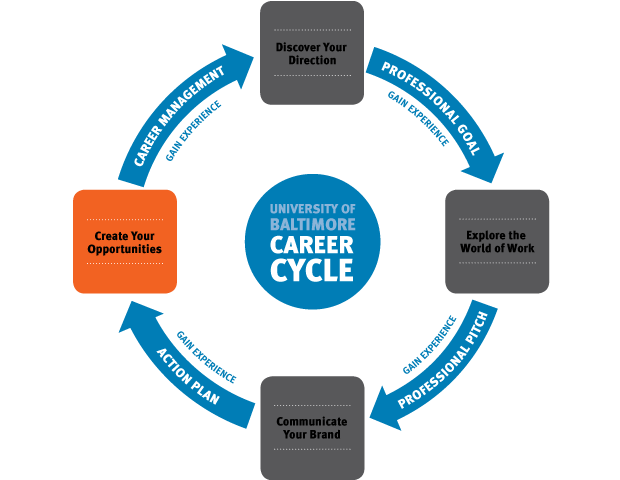
The fourth Phase of the UBalt Career Cycle is Create Your Opportunities. In this phase students begin to interview for positions and put their career into motion to attain their professional goal. In this phase students use their professional pitch and professional brand to connect with employers, activate their network, and land the internship or job of their dreams
Action Steps
As mentioned previously, each phase of the UBalt Career Cycle has an accompanying action step. Activities suggested to help you Create Your Opportunities include interviewing for positions, engaging your network, and implementing your action plan. The Action Step is to Create Your Opportunities is to practice Career Management.
| Communicate Your Brand – Career Activities | ||
| Practice Interviewing | Engage Your Network | Conduct a Job/Internship Search |
| Developing an error free resume that highlights your accomplishments and experience is an essential component of your brand | Your online presence also reflects your. Establishing a student profile on LinkedIn and maintaining a positive presence on other accounts is important.
|
The more professional contacts you have, the more opportunities you will have access to.
|
| Create Your Opportunities – Action Step |
| Career Management
Once you complete the career activities listed above you are ready to Create Your Opportunities. You will begin to actively search for opportunities by engaging your network. You will also conduct a practice interview to prepare for connecting with potential employers. |
For assistance with this Action Step you can access the Career Management Plan. You can also use the following resources to help you create Career Management Plan:
- UBalt Interview Guide
- Arts & Sciences Career Guide
- Business Career Guide
- Public Affairs Career Guide
Connecting with Employers
Most career centers assist students with employers contacts by holding career fairs, hosting employers on campus and offering a job portal. At The University of Baltimore, students and alumni have access to UBworks, a free job portal where employers post internships and jobs directly to students. UBworks is also where students schedule an appointment with their assigned Career Specialist and sign up for career events.
